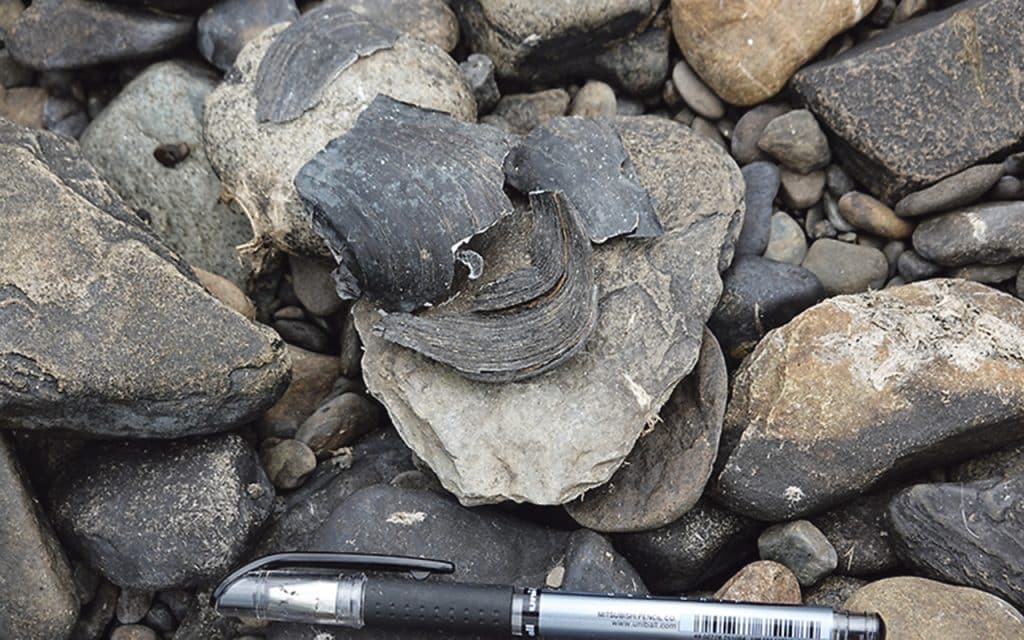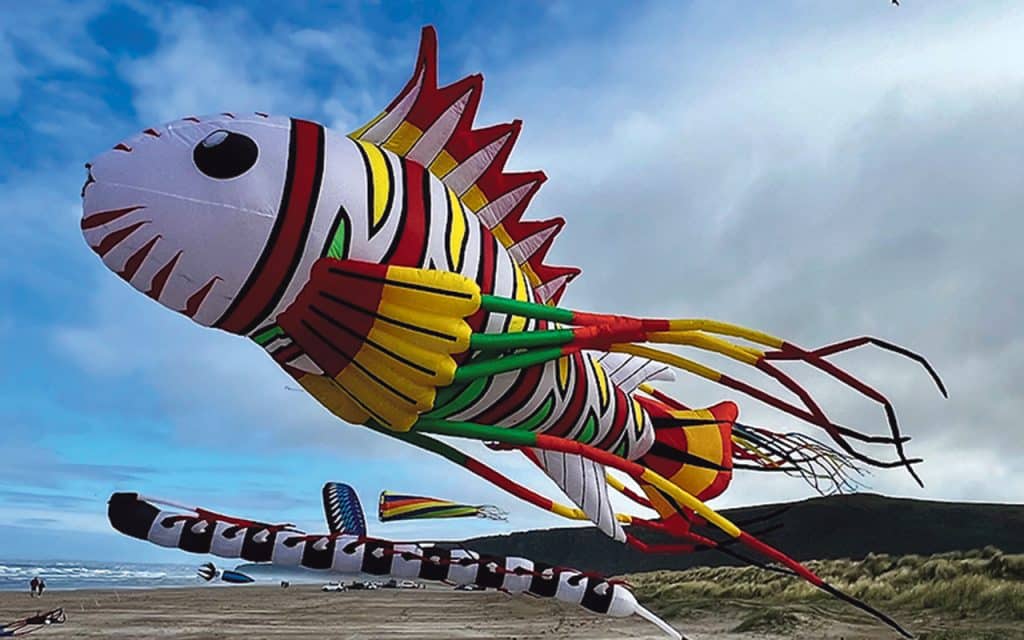This month Andrea Reichstein, a member of the Save Murragh Action Group committed to protecting the Bandon River Valley, discusses the importance of fresh water pearl mussels.

They’re not wearing capes, but they might as well be. Freshwater pearl mussels are quiet superheroes of our waterways. They can clean water so thoroughly that it could be used as drinking water without any treatment. One single mussel can filter up to 50 litres of water a day, removing suspended particles, excess nutrients, and even pollutants like bacteria. They help salmon and trout resist bacterial infections – some of which are worsened by fish farms – and they could even be used one day in water treatment applications. The tragedy is, we might never get that far. They might be gone before we even realise the true severity of what we’ve lost.
Freshwater pearl mussels are a key indicator species – our canary in the coal mine. If they are struggling, it’s a very bad sign. They support entire ecosystems, from insects to fish to birds to mammals. And let’s not forget, we depend on healthy river systems too – not just for drinking water, but for angling, tourism, and our own wellbeing.
Sadly, these mussels – and our rivers with them – are in serious trouble. Over the last century, the European population has declined by 90 per cent. Freshwater pearl mussels are now critically endangered, just one step from being extinct in the wild, and only two steps from disappearing completely.
However there is a silver lining: Ireland still has some of the best remaining populations of freshwater pearl mussels in Europe. But if we want to keep them, we urgently need to protect them. So what are they exactly? What do they do? And why are they both so important and so vulnerable?
Freshwater pearl mussels are bivalve molluscs – animals without a spine, protected by two hard outer shells. The adults live buried in clean riverbeds made up of gravel, sand, and small stones. They need gentle shade and flowing water; not so fast they’re washed away, not so slow that the oxygen disappears. They prefer rivers with intact floodplains and are sensitive to both extreme flooding and low water levels. While most live in rivers, some are also found in lakes.
They are astonishingly long-lived. In Ireland, they live around 120 years. In colder countries like Finland or Norway, they can live over 200 years: one specimen was confirmed to be 286-years-old. In warmer places like Spain, life expectancy drops to just 40–50 years. Like trees, they form growth rings that can be counted to tell their age.
Their life cycle is quite amazing – and frankly, their odds of surviving to adulthood are almost impossibly small. It all starts with the female, who holds the eggs inside her shell for about four weeks. The eggs develop into baby mussels (called glochidia), and in summer she releases up to four million of them into the water. At that point, they’re just 0.04 to 0.07 mm in size – already with little shells open, ready to snap shut.
To survive, a glochidium must find a trout or salmon and clamp onto its gills. Almost all of them, 99.99 per cent, fail. The lucky few attach and stay there for about nine months. During that time, they travel wherever the fish goes.
It’s a symbiotic relationship. The mussels benefit by having a mobile, safe host. But the fish benefit too. The presence of glochidia helps protect them from certain bacterial diseases, even for several months after the mussels detach. And the more glochidia present, the better the fish’s chances of surviving infection. The fish, in turn, help spread the mussels to new areas.
By early summer, the young mussels drop off the fish. Now around 0.4 mm long, they must land in the right kind of riverbed – clean, with good oxygen flow. If they do, they immediately bury themselves. For the next five years they stay hidden, feeding from the riverbed. If there’s too much silt and the sediment clogs, they’ll suffocate or starve.
When they reach about 2 mm in size, the juveniles push themselves upright, still two-thirds buried, and begin filter feeding. They don’t move much, usually only a few metres in a lifetime, but if they need to, they can travel up to a metre a day. It takes them another seven years at least to reach maturity and start the cycle again.
They feed by filtering out organic particles from the water, especially plant detritus like meadow grass, which is rich in calcium and vital for building their shells. A single mussel can filter around 50 litres of water daily, which makes a visible difference to water clarity. But the impact goes deeper. Cleaner water directly benefits spawning trout and salmon, and the whole river ecosystem.
Any inorganic particles they filter, like sand, are wrapped in mucus and returned to the river. But if there are too many inorganic particles and not enough food, the mussels expend more energy filtering than they gain. If that happens for too long, they can starve to death.
Too much silt on the riverbed, often from sedimentation, can kill both juveniles and adults. Sedimentation sources include forestry, soil erosion, riverbank damage, construction work, and airborne dust. Nutrient pollution also causes big problems. Extra nitrogen and phosphorus (from fertilisers, slurry, waste, etc.) leads to algal blooms and rampant growth of filamentous algae and rooted plants. These rob the river of oxygen and make the habitat unliveable.
The decomposition of organic material further reduces oxygen. That material can come from dying algae, but also from human and animal waste, leaking septic tanks, decaying vegetation, damaged peatlands, and industrial effluent. According to the National Parks and Wildlife Service (NPWS), pressures on mussel populations come from both point sources (like quarries, gravel pits, and wastewater plants) and diffuse sources (such as agriculture, overgrazing, forestry, and on-site wastewater systems).
Right now, Ireland’s freshwater pearl mussel population consists mainly of old adults. Our rivers are not clean enough for juveniles to survive the early years after they drop off their host fish. That means our populations are not sustainable. In a healthy river, you’d find mussels of all ages. Without young mussels, they will disappear.
But all is not lost. There is hope. Across Europe and here in Ireland, there are projects working to protect these fascinating creatures. Some raise awareness, others improve habitats or breed mussels in labs to reintroduce them once they’ve made it past the vulnerable juvenile phase.
One great example was the Pearl Mussel Project, which ran in Ireland from 2018 to 2023. It was a results-based scheme that worked with farmers in selected catchments to support practices that help freshwater pearl mussels. Hopefully, its success will inspire a follow-up project that includes farmers along all Irish rivers where the mussels are found.
There’s something every one of us can do: raise awareness. Talk about the freshwater pearl mussel. Share what you’ve learned. Support clean water initiatives in your community. Protect your local rivers and streams. These actions, small as they seem, really do add up.
Too often, the protection of this highly endangered species is seen as an inconvenience – something that gets in the way of developments, roadworks, or quarries. But just because a species is rare doesn’t mean it’s not important. And just because saving them is hard doesn’t mean it’s not worth it.
If people had always thought that way, so many things would never have been achieved. Conservation takes effort, belief, and a willingness to think long-term.
Here in West Cork, we are lucky to have two known populations of freshwater pearl mussels: one in the upper Ilen River, and one in the upper and middle Bandon River, including at least one of its tributaries. There are still good numbers in the Bandon River, and records confirm their presence as far downstream as Bandon town. Both the Ilen and the Bandon still support decent salmon populations, although they are declining rapidly. Part of the Bandon River is a Special Area of Conservation (SAC), with freshwater pearl mussels as a qualifying interest.
Meanwhile, we are expecting a proposal for a new sand and gravel quarry, about 80 acres in size, to be resubmitted this summer in Murragh, right beside the Bandon River and one of its tributaries.
Do we really want to risk such a sensitive river ecosystem for short-term gain?


